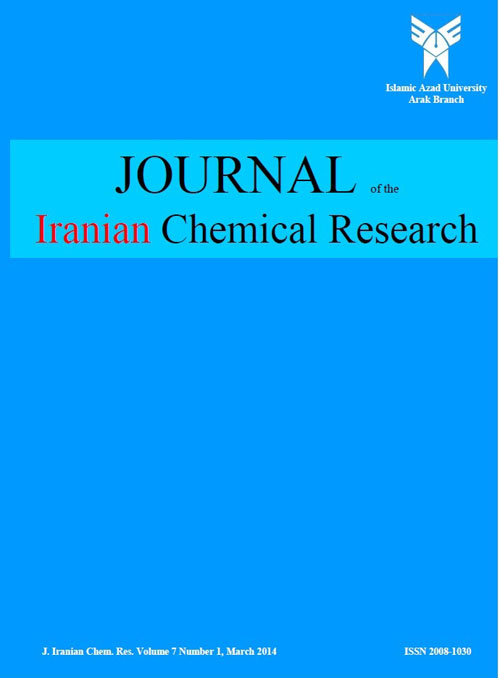فهرست مطالب

Journal of the Iranian Chemical Research
Volume:2 Issue: 2, Spring 2009
- تاریخ انتشار: 1388/03/30
- تعداد عناوین: 8
-
Pages 79-86Matrix Analysis of Corrosion Inhibition Phenomena (MACIP), in which an inhibitor is considered as a point in a multi-dimensional virtual efficiency space, was performed on some pyridine derivatives. The needed molecular parameters such as HOMO and LUMO energy levels, charge densities on hetero atom, dipole moment, heat of formation, and total energy values were obtained by means of semi-empirical quantum chemical methods; such as the AM1, MNDO, MINDO/3, and PM3. The obtained results for 3,5- dimethyl pyridine and 2,4- dimethyl pyridine reveal out the fact that the last molecule is a better corrosion inhibitor as indicated in literature.Keywords: Pyridine corrosion inhibitors, Isolated inhibitor model, Matrix analysis, Virtual efficiency space, Semi, empirical methods
-
Pages 87-94Pb and Cd in water samples were determined by cloud point extraction (CPE) with sodium diethyldithiocarbamate (DDTC) as the chelating agent and octylphenoxypolyethanl (Triton X-114) as the surfactant prior to flame atomic absorption spectrometry (FAAS) determination. The main factors of affecting the extraction and detection processes were optimized. The preconcentration of 10 mL of standard solutions gave enhancement factors of 35 and 75 and the detection limits of 9.41 and 0.40 ng mL-1 for Pb and Cd, respectively. The proposed method was applied satisfactorily to the determination of Pb and Cd in seawater and lake water. Good agreement was obtained between the added and measured analyte amounts through the recovery of experiments.Keywords: Cloud point extraction, Flame atomic absorption spectrometry, lead, cadmium, Diethyldithiocarbamate
-
Pages 95-109In order to represent the potential energy function over the whole range of R, many potential energy functions have been proposed. In the present paper, we employ many potential energy functions, to use Numerov method for solving the nuclear Schrödinger equation for the IF molecule, as an example of a heteronuclear diatomic molecules. Then we determine the spectroscopic constants e ω , e e x ω , e B , and e α of the IF molecule from vibrational and vibrationrotation levels obtained from solution of the nuclear Schrödinger equation. Finally, by comparison of obtained values with the experimental ones, their accuracy rate is determined as well as their deviation percentages from experimental values.Keywords: Spectroscopic constants, Potential energy functions, Heteronuclear diatomic molecules
-
Pages 111-119Phenylazo and benzothiazolylazo derivatives of trifluoroacetylacetone and hexafluoroacetylacetone have been synthesized and characterized. Analytical and spectral data revealed the existence of phenylazo derivatives in the intramolecularly hydrogen-bonded ketohydrazone form while the benzothiazolylazo derivatives in the azo-enol form. The monobasic bidentate coordination of the phenylazo derivatives and monobasic tridentate coordination of the benzothiazolylazo derivatives in their Ni(II), Cu(II), Zn(II) and Pd(II) complexes have been established by analytical and spectral data.Keywords: Fluoro, ?, diketones, Benzothiazolylazo, ?, diketones, Phenylhydrazones, metal complexes
-
Pages 121-131The determination of the optimal distribution of the catalytic activity profile, which maximizes the catalytic effectiveness, in created unsteady state conditions, is analyzed and treated numerically for the case of a simple reaction. It was proven that the modulation, of the temperature and the reactant concentration of the external bulk fluid, leads to a considerable increase of the catalytic effectiveness. The optimal active element distribution is a Dirac- δ function i.e. all the catalyst must be deposited at a specific distance from the center of the catalytic pellet. It was shown that this optimal position changes with time in a sinusoidal manner. This purpose can be achieved by the use of ultrasounds to artificially control the activity profile.Keywords: Unsteady state, Optimal catalyst distribution, Forced perturbation, Temperature modulation, Concentration modulation
-
Pages 133-144The NMR spectra of azo dyes, 5-arylazobarbituric (5a-g), 5-arylazo-1,3-dimethylbarbituric (6a-g) and 5-arylazothiobarbituric acids (7a-g) were studied in DMSO-d6 in different concentrations. An intramolecular hydrogen bond was observed and indicating that the hydrazone forms is mostly predominant. The peak of the hydrazone proton was severely broadened and its chemical shift appeared at down field due to intramolecular hydrogen bond. Existence of nitro group at ortho-position on phenyl ring caused the chemical shift value of the proton of hydrazone form in 5a-7a to be more deshielded than other hydrazone protons in 5bg− 7b-g due to bifurcated intramolecular hydrogen bond and anisotropic ring-current effect. Dyes 6 shows two tautomers in NMR time scale at low concentration in DMSO-d6.Keywords: Azo, hydrazone tautomerism, Solvatochromic dyes, 5, Arylazobarbituric acids, Bifurcated intramolecular hydrogen bond
-
Pages 145-149The preparation of nano-sized TiO2 by titanium tetraisopropoxide (Ti(OiPr)4) via sol-gel method using acid as a catalyst is investigated and the optimized conditions concerning the proportional amount of acid, water, alcohol is established by XRD and SEM. The effect of calcination temperature on phase transformation of TiO2 (rutile, anatase and brookite) was determined by XRD. The smallest grain size of TiO2 powder we have obtained is 25 nm for anatase at 400 ºC by controlling the acidity and the mole ratio of starting materials.Keywords: Titania, Sol, gel, Rutile, Anatase, X-ray diffraction (XRD)
-
Pages 151-156The kinetics of iodination of the phenol and substituted phenols using pyridinium iodochloride in methanol has been studied under varying conditions. The rates show first order kinetics each in pyridinium iodochloride and phenols. The rates of reactions are measured at different temperature and activation parameters for all phenols computed. Hammett plot is found to be valid and the corrletion between the enthalpies and free energies of activations is reasonably linear with an isokinetic temperature 359.55 K. Similarly log A values of all the phenols are optimized corresponding to Ea of phenols through the equation, log A = log kobs Ea / 2.303 RT.Keywords: Kinetics, Iodination, phenols, Pyridinium iodochloride


